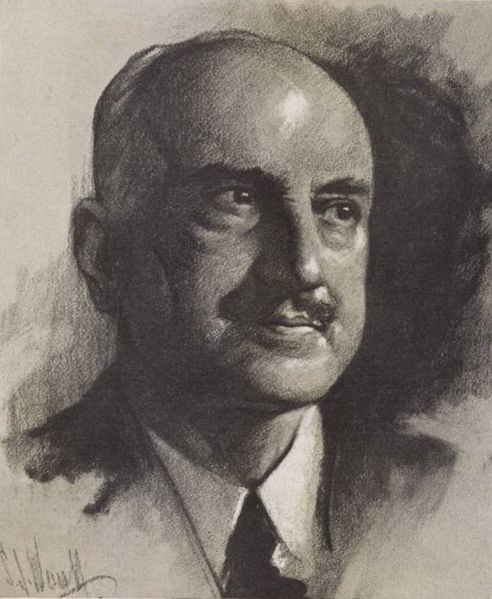<Back to Index>
- Philosopher Jorge Augustín Nicolás Ruiz de Santayana y Borrás, 1863
- Architect Ralph Adams Cram, 1863
- Bulgarian Revolutionary Hristo Tatarchev, 1869
PAGE SPONSOR

George Santayana (born Jorge Agustín Nicolás Ruiz de Santayana y Borrás in Madrid, December 16, 1863; died September 26, 1952, in Rome) was a Spanish American philosopher, essayist, poet, and novelist. A lifelong Spanish citizen, Santayana was raised and educated in the United States. He wrote in English and is generally considered an American man of letters. At the age of forty - eight, Santayana left his position at Harvard and returned to Europe permanently, never to return to the United States. His last will was to be buried in the Spanish Pantheon in Rome.
Santayana is known for his comments: "Those who cannot remember the past are condemned to repeat it", and "[O]nly the dead have seen the end of war." The latter sentence has often been falsely attributed to Plato. The philosophical system of Santayana is broadly considered Pragmatist due to his concerns shared with fellow Harvard University associates William James and Josiah Royce. But, Santayana did not accept this label for his writing and eschewed any association with a philosophical school; he declared that he stood in philosophy "exactly where [he stood] in daily life."
Born Jorge Agustín Nicolás Ruiz de Santayana y Borrás on December 16, 1863 in Madrid, he spent his early childhood in Ávila. His mother Josefina Borrás was the daughter of a Spanish official in the Philippines, and Jorge was the only child of her second marriage. She was the widow of George Sturgis, a Boston merchant with whom she had five children, two of whom died in infancy. She lived in Boston for a few years following her husband's death in 1857, but in 1861 moved with her three surviving children to live in Madrid. There she encountered Agustín Ruiz de Santayana, an old friend from her years in the Philippines. They married in 1862. A colonial civil servant, Ruiz de Santayana was also a painter and minor intellectual.
The family lived in Madrid and Ávila until 1869, when Josefina Borrás de Santayana returned to Boston with her three Sturgis children, as she had promised her first husband to raise the children in the US. She left the six year old Jorge with his father in Spain. Jorge and his father followed her in 1872, but his father, finding neither Boston nor his wife's attitude to his liking, soon returned alone to Ávila. He remained there the rest of his life. Jorge did not see him again until he had entered Harvard University and took his summer vacations in Spain. Sometime during this period, Jorge's first name was anglicized as George, the English equivalent.
He attended Boston Latin School and Harvard University, where he studied under the philosophers William James and Josiah Royce. After graduating from Harvard, Phi Beta Kappa in 1886, Santayana studied for two years in Berlin. He returned to Harvard to write his dissertation on Hermann Lotze and teach philosophy, becoming part of the Golden Age of the Harvard philosophy department. Some of his Harvard students became famous in their own right, including T.S. Eliot, Robert Frost, Gertrude Stein, Walter Lippmann, W.E.B. Du Bois, and Harry Austryn Wolfson. Wallace Stevens was not among his students, but became a friend. From 1896 to 1897, he studied at King's College, Cambridge.
In
1912, Santayana resigned his Harvard position to spend the rest of his
life in Europe. He had saved money and been aided by a legacy from his
mother. After some years in Ávila, Paris and
Oxford, after 1920, he began to winter in Rome,
eventually living there year round until his death. During his 40 years
in Europe, he wrote nineteen books and declined several prestigious
academic positions. Many of his visitors and correspondents were
Americans, including his assistant and eventual literary executor,
Daniel Cory. In later life, Santayana was financially comfortable, in
part because his 1935 novel, The Last Puritan, had become an unexpected best seller. In turn, he financially assisted a number of writers, including Bertrand Russell, with whom he was in fundamental disagreement, philosophically and politically. Santayana never married.
Santayana's main philosophical work consists of The Sense of Beauty (1896), his first book length monograph and perhaps the first major work on aesthetics written in the United States; The Life of Reason five volumes, 1905 – 6, the high point of his Harvard career; Scepticism and Animal Faith (1923); and The Realms of Being (4 vols., 1927 – 40). Although Santayana was not a pragmatist in the mold of William James, Charles Sanders Peirce, Josiah Royce, or John Dewey, The Life of Reason arguably is the first extended treatment of pragmatism written.
Like many of the classical pragmatists, and because he was also well versed in evolutionary theory, Santayana was committed to metaphysical naturalism. He believed that human cognition, cultural practices, and social institutions have evolved so as to harmonize with the conditions present in their environment. Their value may then be adjudged by the extent to which they facilitate human happiness. The alternate title to The Life of Reason, "the Phases of Human Progress", is indicative of this metaphysical stance.
Santayana was an early adherent of epiphenomenalism, but also admired the classical materialism of Democritus and Lucretius (of the three authors on whom he wrote in Three Philosophical Poets, Santayana speaks most favorably of Lucretius). He held Spinoza's writings in high regard, without subscribing to the latter's rationalism or pantheism.
Although an agnostic, he held a fairly benign view of religion, in contrast to Bertrand Russell who held that religion was harmful. Santayana's views on religion are outlined in his books Reason in Religion, The Idea of Christ in the Gospels, and Interpretations of Poetry and Religion. Santayana described himself as an "aesthetic Catholic". He spent the last decade of his life at the Convent of the Blue Nuns of the Little Company of Mary on the Celian Hill at 6 Via Santo Stefano Rotondo in Rome, where he was cared for by the Irish sisters. Santayana's one novel, The Last Puritan, is a bildungsroman, that is, a novel that centers on the personal growth of the protagonist. His Persons and Places is an autobiography. These works also contain many of his sharper opinions and bons mots. He wrote books and essays on a wide range of subjects, including
philosophy of a less technical sort, literary criticism, the history of
ideas, politics, human nature, morals, the subtle influence of religion
on culture and social psychology, all with considerable wit and humor.
While his writings on technical philosophy can be difficult, his other
writings are far more accessible and have literary quality. All of his
books contain quotable passages. He wrote poems and a few plays, and left an ample correspondence, much of it published only since 2000. In his temperament, judgments and prejudices, Santayana was very much the Castilian Platonist, cold, aristocratic and elitist, a curious blend of Mediterranean conservative (similar to Paul Valéry) and cultivated Anglo - Saxon, aloof and ironically detached. Russell Kirk discussed Santayana in his The Conservative Mind from Edmund Burke to T.S. Eliot. Like Alexis de Tocqueville, Santayana observed American culture and character from a foreigner's point of view. Like Ralph Waldo Emerson,
he wrote philosophy in a literary way. Although he declined to become
an American citizen and resided in fascist Italy for decades, Santayana
is usually considered an American writer by Americans. But, he said
that he was most comfortable, intellectually and aesthetically, at Oxford University. His materialistic, skeptical philosophy was never in tune with the Spanish world of his time. In the post - Franco era, he is gradually being recognized and translated. Ezra Pound includes Santayana among his many cultural references in The Cantos, notably in "Canto LXXXI" and "Canto XCV". Chuck Jones used Santayana's description of fanaticism as "redoubling your effort after you've forgotten your aim" to describe his cartoons starring Wile E. Coyote and Road Runner.
Santayana is remembered in large part for his
aphorisms,
many of which have been so frequently used as to have become
clichéd. His philosophy has not fared quite as well. Although he
is regarded by most as an excellent prose stylist, Professor John Lachs (who is sympathetic with much of Santayana's philosophy) writes in his book On Santayana that the latter's eloquence may ultimately be the cause of this neglect. Santayana influenced those around him, including Bertrand Russell, who in his critical essay admits that Santayana single - handedly steered him away from the ethics of G.E. Moore. He also influenced many of his prominent students, perhaps most notably the eminent poet Wallace Stevens. Those who have studied he philosophies of naturalism or materialism in the 20th century come inevitably to Santayana, whose mark upon them has been great. Santayana is quoted by the Canadian - American sociologist Erving Goffman as a central influence in the thesis of his famous 1959 book The Presentation of Self in Everyday Life.
